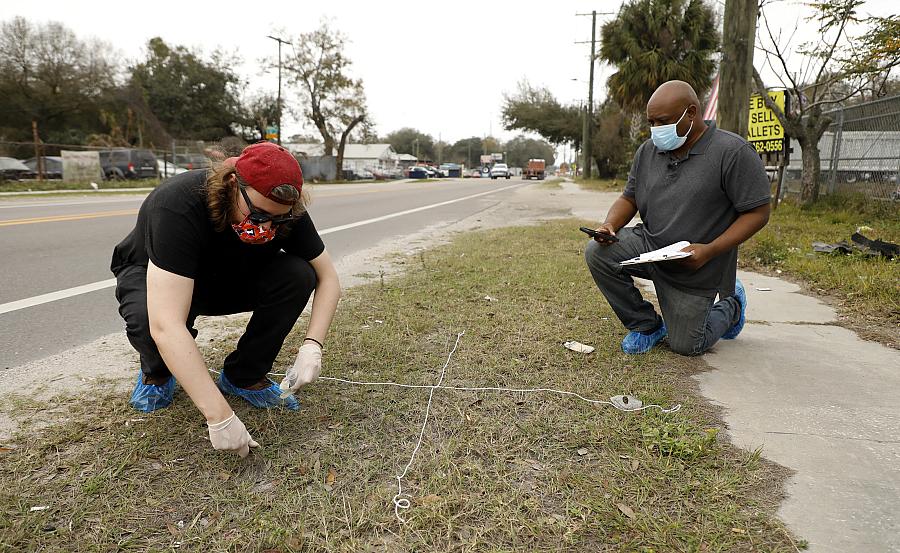A new investigation will delve into pollution threatening water system in Florida’s Tampa Bay region

Tampa Bay Times reporters Eli Murray and Corey Johnson take soil samples near the Gopher Resource factory in January 2021 in Tampa, Florida. Samples were sent to a lab and tested for lead.
Eli Murray
For the past three years, I’ve been covering environmental health topics in the Tampa Bay region ranging from contaminated drinking water in schools to dangers at a local lead factory.
I was first drawn to environmental reporting because of the rich data opportunities, but I stumbled into a passion for telling these stories because of the real, tangible impact they can have on the health of a community.
In 2018, I worked alongside Corey Johnson, a fellow member of the Tampa Bay Times investigative team, to examine the local school district’s handling of lead in drinking water. Our investigation revealed that district officials found elevated results but kept them hidden from parents for a year.
The following year, Corey and I were joined by Rebecca Woolington as we began our probe into the local lead smelter, owned and operated by Gopher Resource. Through our reporting, we uncovered a factory plagued with faulty equipment and processes that was exposing workers to dangerous levels of the neurotoxin. Often, lead levels were so high inside the factory that workers' company-issued respirators could not adequately protect against them.
But the hazards also extended beyond the factory’s walls.
We found case after case of workers unwittingly bringing home lead dust and exposing their children. We also detailed the way the factory threatened the environment and the surrounding community, uncovering a pattern of polluting the air and water that started in the 1960s and continued after Gopher bought the plant 15 years ago. And we revealed the factory’s practice of taking steps to lower emissions on days when it knew regulators were watching.
As a result of our reporting, the Occupational Safety and Health Administration and the Hillsborough County Environmental Protection Commission opened separate investigations into conditions at the smelter. Both investigations confirmed our findings, and the smelter was fined more than $800,000 and required to make changes. Officials also doubled the number of air samples they take around Gopher and began testing on a new, randomized schedule.
After we published these stories, we heard from readers who were concerned about other potential pollution sources, and we decided to stay focused on possible environmental health issues affecting our region.
That has led me to begin investigating potential point sources of contamination in Hillsborough County that could be threatening the surface and groundwater. More than 150 sites could be contaminated, and I plan to conduct targeted environmental testing to see whether they present a risk to surrounding communities. Some of these sites are near apartment complexes and parks, but the level of risk to the public from many of them is unknown and appears not to be well-studied.
Hillsborough County, which is Florida’s fourth largest and home to Tampa, is particularly vulnerable to surface or groundwater pollution. The county is bounded by Tampa Bay on the west, and the hydrological systems in the county — which direct the flow of groundwater — are interconnected with those in the bay. That means water contamination on land can have possibly wide-ranging effects in the region. Such contamination can threaten the balance of marine life.
The eastern side of Hillsborough County has largely been put to agricultural and industrial use. People in this area experiencing poverty and living in more rural communities rely on well water. Contamination of the surficial aquifer, which is the aquifer closest to the surface, has the potential to affect thousands of people in this part of the county.
Below the surficial aquifer is a larger aquifer, the Floridan, which provides freshwater to much of the state. In West-Central Florida, including Hillsborough County, the confining layer between the two aquifers is permeable in areas. This means that groundwater contamination of the surficial aquifer in Hillsborough could potentially seep into the Floridan aquifer, widening the scope of possible pollution.
As part of this project for the 2022 National Fellowship, I’ll also be evaluating risks beyond groundwater, including the potential for soil and air pollution from the sites, and assessing any possible impact on, or threat to, public health. To do this, I’ll analyze whatever data I can uncover and will contact an array of subject-matter experts to vet my findings.
Lastly, my reporting will also examine the regulatory framework in place to address these sites and how that framework has operated over the past several decades. My hope is that this project will be illuminating for readers by deeply probing an issue that has existed for some time and remains largely unknown to Floridians.

